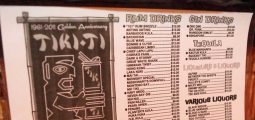Diving Into the Future: What Lies Ahead for the American Dive Bar

I recently read an article suggesting that the existence of the American dive bar is being threatened by the onset of craft cocktail culture. The article was critical of a particular market where even iconic dive bars are closing their doors, while craft cocktail bars are popping up on every corner. As a part owner and manager of a craft cocktail establishment, I assure you, the American dive bar is safe, categorically speaking. What is being threatened, however, is the weak business model (trust me, many of those craft bars won’t make it, either).
Let’s define the ‘dive bar’: The dive bar is comforting. We identify with it. It isn’t perfect. It’s not necessarily clean. It’s not trying too hard. It doesn’t care how we look. We don’t have to think too hard about what we want. It isn’t judging us for having low standards, or for not being able to pronounce a fancy vermouth. It is the industry path of least resistance, which is why it will always exist. The difference between the dive bar of yesterday and the dive bar of tomorrow is that future dive bars will need to be executed strategically as such, whereas in the past they were successful mostly by default.
Our industry, like many others, is undergoing a tremendous revolution fueled by everything from pop-culture, a more knowledgeable consumer, and increasing costs of operations. In essence, the margin for error is narrowing. That narrowing margin has started to expose the weaknesses of many business models.
In the past, the dive bar thrived – not because it was a carefully thought out business concept, but because it was in sync with what the average bar-goer was looking for/expecting from a service environment. In short, it was easy. As the trends continue toward responsible hospitality and quality consumption (vs. quantity consumption), some of that market share is being shaved off, leaving dive bars to compete for the business of a shrinking demographic.
In addition, a built-in threat to the sustainability of the dive bar is that it targets a clientele that is not necessarily loyal. Very few dive bars enjoy iconic brand identity. Due to the very nature of the dive bar, most of them deal in the same products and same standard for service, which means that their target clientele’s needs are met regardless of which bar they choose; They are happy to go to Bob’s one night, and Joe’s the next. The only determining factors dictating where dive bar-goers go are where their friends will be and/or the price of the nightly special. Essentially, dive bar owners compete for the business of cheap, fickle customers.
Previously, the sheer volume of these consumers allowed for incredible profitability despite these facts. With a shrinking percentage of the market share of the target consumer, however, the future dive bar will be dedicated to providing a reason for people to come there vs. another (i.e. creating brand identity). Further, as dive bars are profit margin-driven (vs. revenue-driven), and typically rely on volume sales. Dive bar owners of the future will remain competitive only through an acute awareness of the equations governing profitability, and the importance of bar efficiency and ergonomics. The days of the dive bar being a money printing machine with an absentee operator are over. The dive bar has gone from being an unsinkable ship, to a much more vulnerable vessel, in need of a knowledgeable and involved captain.
There is only one reason a business fails: More money went out than came in. The bar biz is a unique industry that everyone seems to think they can do well in, regardless of experience. With a substantial, generally accepted mark-up on cost of goods, and a reasonably recession-proof product, a bar seems like a safe bet. The incredible failure rate, unfortunately, is explained by the human element.
A pipe dream and over-eager investors do not necessarily lead to success. You need to do what all business owners do to ensure success, this includes investing in things like sales training for your staff, from places like Impel Dynamic, and staying up to date with market trends so that you can adjust your business accordingly rather than falling behind. The majority of mistakes are made in the opening process: signing a lease that exceeds the standard gross revenue percentage allocation for that fixed cost; not having a very specific target demographic in mind (and not building out the space to meet the needs of that very specific consumer); not investing the proper amount in the development of a hiring/recruiting/training philosophy; not understanding staffing strategies that maximize service and minimize labor (so as to ensure staff profitability/retention, etc.). The future dive bar will need to be executed with the same strategic development required by any other concept. The difference between owning a business and building a brand starts here. The key will be to determine what, exactly, makes a great dive bar.
For example, if you are the dive bar that can get a drink in someone’s hand the fastest, and with a smile, you can maintain a slightly higher price point (thereby increasing profitability). You can offset the slight increase in price with the added value of quick, friendly service. In conjunction, a bar that is set up for ergonomics and efficiency is geared for exponentially higher profits. Imagine a volume bar that is simply rearranged to create two more drinks every 15 minutes. Consider just the added revenue of eight drinks per hour (let’s say just $4/each…so $32/hour) X 7 hours of peak business Thursday through Saturday (so…$32 x 7 x 3 = $672/week) X 52 weeks/year. The result is an increase in gross revenue of $34,944… and this is per bartender. If you have a volume bar with two bartenders, or three, you can easily double and triple that number.
The American dive bar is not going away, but it is becoming a more difficult model to pull off successfully. The silver lining is that the more our industry requires actual business skills and product knowledge, the lower the failure rate will become. Our industry boasts incredible opportunity for entrepreneurs who are willing to put in the time and effort to be present. The only thing going extinct is the lazy bar owner with zero business skills who does not care to be present, and who does not care to pay attention to evolving industry trends.
Related Articles
Wine, a Melodrama: How They Got it All Wrong, but it Turned Out All Right
Act 1, Scene 1 It is a cool, foggy evening circa late 1970’s or early ‘80’s. The curtain rises. Mandolin
Wine Recommendation: Varozza Vineyards
Every year, twice a year, I make it a point to attend the bi-annual fall and spring open house events
Pesach Sameach! (Happy Passover!)
I remember vividly my first Passover Seder. I had been invited by dear friends, Lou and Rose Leviticus, into their
No comments
Write a commentOnly registered users can comment.















